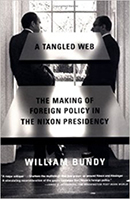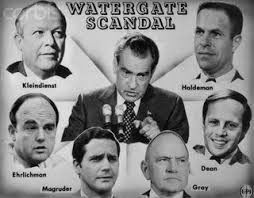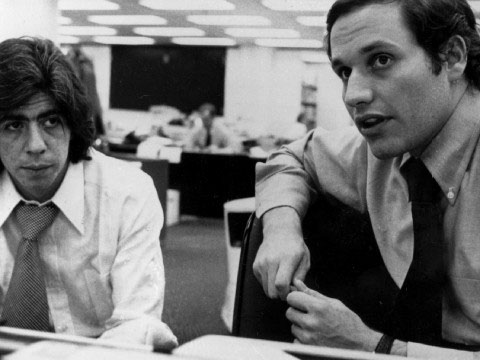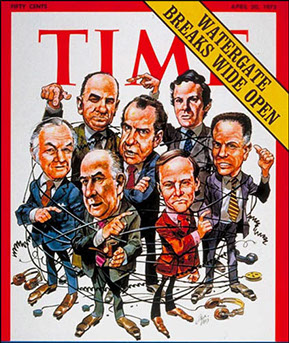Uncovered Cover-up: Watergate
By Ana Corcoran

Fred Emery
Fred Emery was an editor to the highly acclaimed London Times.He lived through the 1970s and the Watergate scandal, though he lived in Europe.



Perhaps the most complex, and certainly the most damaging scandal in American politics is the Watergate scandal, involving the countless illegal activities and obstructions of justice by 37th President Richard M. Nixon and his circle. At the time, the complete deception of American people on the activities of the President and his men, during and after the 1972 break-in at Watergate, shattered for many their trust and belief in the integrity of the White House, which was previously one of the most regarded and sacred institution of the country. Nixon’s utter abuse of power overshadows his many achievements in foreign policy during the Cold War. The fact that he had so many accomplishments only “heightens the tragedy of self-infection that this complex man, effective and visionary in high policy, should have his epitaph: Watergate.”1 Although he almost did get away unscathed from the whole affair, a series of tapes and revelations from inside sources ultimately doomed any chance of escape. In the end, this extensive cover-up proved fatal to the presidency, whereas had Nixon come out and admitted and apologized for the break-in at Watergate, he may have maintained his dignity and that of the White House, yet this was not the case. With a settled and unbiased viewpoint, in his work Watergate: The Corruption and Fall of Richard Nixon, Fred Emery eloquently unravels the intricate motives, actions, lies and truths of the most notorious scandal in United States history.
The beginning of Watergate: the Corruption and Fall of Richard Nixon focuses on Nixon’s overpowering desire to be a two-term president and how this motivated so many of his corrupt actions leading up to Watergate. Emery reveals that from the beginning of his first term, Nixon desired two indispensable commodities: money and political intelligence. These two incentives, along with an innate suspicion of and dislike for the Democratic Party, drove Nixon to extreme measures when he felt his presidency threatened. Additionally, in February 1971, Nixon decided to use Lyndon B. Johnson taping mechanisms to record virtually all of his own conversations. The earlier publication of Nixon’s secret bombing in Cambodia along with the turbulence surrounding the Vietnam War led to the formation of the infamous Committee to Re-Elect the President (which later earned its fitting nickname “CREEP”) in spring 1971. Then on June 13, 1971, Daniel Ellsberg’s Pentagon Papers were published in The New York Times, exposing the untold deceit of US involvement in the Vietnam War. Emery goes on to tell just how transfixed Nixon became on the downfall of Ellsberg as revenge through the special White House counsel’s Charles Colson’s revelation that “The president… said in effect ‘I don’t give a damn how it is done, do whatever has to be done to stop these leaks and prevent further unauthorized disclosures; I don’t want to be told why is can’t be done. . . . I don’t want excuses, I want results, I want it done, whatever the cost.”2 This extreme mindset led to the decision to form a White House Special Investigations Unit, more popularly known as the Plumbers, because their job was to stop any leaks in the White House. It was the Plumbers, whose chief members were G. Gordon Liddy, Egil Krogh, and David R. Young, who participated in the first undercover break-in during Nixon’s presidency into Ellsberg’s psychiatrist, Dr. Fielding’s office in attempt to find dirt on Ellsberg. Emery’s insight in Chapter 4 that “Nixon’s ‘I don’t care how it’s done’ attitude in pursing Ellsberg and the Democrats rapidly permeated his staff’s approach to political intelligence” rings true as parts of Liddy’s GEMSTONE plans were approved and the Plumbers prepared to break into the Democratic National Committee headquarters at Watergate.3
Emery then gives a detailed account of the immediate results of the break-in of Watergate on the night of June 17, 1972. Emery highlights the fatality of including James McCord on the break-in team, as he was a member of the CRP and easily traceable to Nixon. This fatality proves itself with McCord’s decision to re-tape the locks at the DNC, which ultimately lead to their capture. The gravity of the Plumbers capture is juxtaposed to the seemingly calm mood in the White House the following weekend. The pinnacle of this mood is summed by the placement of deputy director of the reelection campaign, Jeb Stuart Magruder’s statement that “the cover-up, thus, was immediate and automatic; no one ever considered there would not be a cover-up.”4 Emery uses the later-revealed June 23rd “smoking gun” tape to discredit Nixon’s claim that he had no affiliation or knowledge of the break-in at Watergate. Emery discloses the shameless lies of Nixon on August 29, 1972, at a news conference. Nixon had explicitly stated that no one in the White House was involved in Watergate. He went on to say “What really hurts in matters of this sort is not the fact that they occur… What really hurts is if you try to cover them up.”5 The president felt safe to lie because the belief was that the White House could use their political power and hush money to keep the truth from emerging. Even as Nixon places enormous confidence in his seemingly trustworthy counsel, John Dean, Emery hints at the fact “that his direct line to Dean was a second self-destruct button.”6
Emery strategically parallels the White House’s confidence with the at-the-time secret betrayal of the anchor of the cover-up, John Dean. Emery’s belief that “because of Dean, the secret of Nixon’s tapes was uncovered; because of Dean, the president was publicly and irrevocably tied to Watergate” is amply supported with the behind-the-scenes information included as Dean privately met with his own lawyer, though remaining loyal to the president in public terms, beginning at the end of March 1973.7 By April 15th Nixon realized he had been betrayed by Dean, and Emery describes the havoc than followed as the president loses his men as they one-by-one resigned or went to jail. Emery gave detailed accounts of the conversations between conspirators on several late nights as they scrambled to come up with new cover-ups to cover the old. Emery includes Dean’s shocking manifestation of the top-secret Huston plan, which revealed major obstructions and abuses of power by the White House, due to Dean’s desperation to gain immunity. Emery’s work climaxes as he analyzes Holy Week of 1973, day-by-day as new information against Nixon is leaked. Emery focuses on the men Nixon had to rid himself of, including his top attorney generals, John Mitchell and Richard Kleindiest. These were followed by the more tragic removal of his chief domestic policy advisor, John Ehrlichman, and White House chief of staff, H.R. Haldeman. From an outside perspective, Emery shows that while Nixon was deeply affected by the removal of his top men, even more detrimental was the effect that this removal had as the rest of the country perceived it.
As his book comes to an end with the truth behind the events of Watergate illuminated, Emery portrays Nixon’s internal battle between resigning and going through with the trial for impeachment. The moment Judge Sirica is convinced of Nixon’s guilt and demands Nixon’s tapes is the moment Emery notes as the end for Nixon, as these tapes will bring his ultimate and unnegotiable removal from office, one way or another. Emery writes of the struggles Nixon faced as he fought to continue serving his country as president while under trial against his country in court. Emery also plays on Nixon’s ever-present false hopes, especially shown through his confidence in the republican members of the “grand jury” of the court case. The effect this whole affair had on the general public was presented through the televised impeachment debates. Even before the fatal “smoking gun” tape was released, it was announced that “in all of this, Richard M. Nixon has acted in a manner contrary to his trust as President and subversive of constitutional government, the great prejudice of the cause of law and justice and to the manifest injury of the people of the United States.”8 As Nixon was forced to handover the tapes, the “smoking gun” tape of Nixon speaking about Watergate long before he claimed he was aware of the situation, the self-destruction of Nixon was complete. Emery concludes his book with the inauguration of the new president, Gerald Ford, and his pardon to Nixon.
Emery sought to retell the story of Watergate to a new generation, and did so with a new perspective than those of previous writers. Emery felt the call to write his book in 1990 as he felt that “for the generation of thirty-somethings, Watergate loomed important, but as distant as the Napoleonic Wars.”9 As a means of effectively retelling the story of Watergate with new light, Emery makes extensive use of the taped conversations of the president and his executives that were, at the time of Watergate, not available to writers. These taps provide solid, if at times shocking, evidence of exactly what went on behind the scenes of the biggest scandal in American politics. He claims that however surprising the extent of corruption was, it is even more surprising just how close the White House was to getting away with it.
Fred Emery is the former editor of the London Times and therefore, able to tell the story of Watergate though a “distinctly British perspective.”10 Through the author’s distance from Watergate, in both location and time, Emery is able to give an unbiased account of the true happenings surrounding Watergate. He is the first to have recounted Watergate not immediately following the occurrence, but rather over 20 years later, so he is able to have a composed perspective compared to the rushed and emotional writings produced right after the scandal. Incidents that may have influenced Emery’s writing of his book in 1994 were that by that time, many of the chief participants in the Watergate scandal, including President Nixon himself, had come forward with their own books on the matter. Emery includes references to their works, and their often contradicting claims on what actually happened. Also, the loss of trust and faith in American politics had grown since Nixon’s resignation, manifested in the presidencies of Jimmy Carter and, the only Republican since Nixon, Ronald Regan. There was a general sense of political dissatisfaction that has plagued the White House since Nixon’s resignation. Emery wrote his book to inform the new generation on where the corruption and fall of American politics came from with an unbiased perspective and new information.
Nicholas P. Weber of the Midwest Archives Conference and Michael W. Link of the Center for the Study of the Presidency and Congress both have reviewed Watergate and that Emery does an excellent job covering the range of complexities and complications surrounding the Nixon presidency and the Watergate scandal. Weber states that Emery did sufficiently in reporting the occurrences that led up to Watergate, which is important in understanding the history of it. Weber also finds that “what makes Emery’s work especially poignant and insightful is the large variety of archival records and other materials used to document the story, many of which were not available to those writing at the time of Watergate.”11 Weber focuses on Emery’s use of the Oval Office tapes as having the most fascinating effect on the book, due to their impartial and objective testimonies. Link finds similar satisfaction with Emery’s work and writing style in unraveling Watergate. Summing up the book, Link says “The picture one gets from Emery’s account, however, is less that of political hard-ball specialists engaged in a high stakes chess match, but more that of a game of political musical chairs with each new revelation leading to the resignation and/or indictment of another administration official, ultimately leaving the president himself standing with no other option but to resign.”12 Both reviewers agree that Watergate: The Corruption and Fall of Richard Nixon is a well-written informative read to various levels of readers who wish to gain a better understanding of what really happened surrounding Watergate.
Emery’s Watergate effectively implements many of Nixon’s taped conversations, providing undeniable and revealing evidence on the motives and strategies driving Nixon and his men before, during and after the break-in. These tapes were not available to previous writers on the subject, giving Emery’s book the most complete and in-depth overview of Watergate at the time of its publication. Emery was removed enough from the situation to be able to powerfully account for all the details of the affair, with an unbiased perspective that clearly presents the facts. Emery takes an interesting viewpoint on the matter by centralizing much of the story on Richard Nixon’s desires to get back at the Democratic Party and to save his reputation at all costs. Throughout the work Emery plays on the emotions felt by Nixon that fueled his decisions, contrasted with the reality of what was occurring beyond Nixon’s knowledge. Providing an in-depth and multi-perspective account of Watergate, Emery writes in a way that untangles the tight web of lies, exposing the thoughts and strategies behind those involved, and providing information for anyone who seeks a better understanding of what happened at Watergate as more than “a third-rate burglary attempt.”13
Emery takes the position of the 1970s as a time of severe political crisis. Not only was the fall of Richard Nixon tragic domestically, it also made the country weak in foreign matter. The ultimate legitimacy and authority of the president was questioned through Watergate, and a suspicion surrounding politics was born and remains to this day. In Nixon’s defense he was president during one the country’s most hectic time periods, with the rise of radicals and protesters on everything from civil rights to the Vietnam War. As Nixon’s right-hand man once curiously stated, “Without the Vietnam War there would have been no Watergate” whether or not this is true matters not, as Nixon faced many adversities during his presidency, including Vietnam.14 Emery portrays the 70’s as a time of both continuation and break from the rambunctious 60’s. Nixon represented the “silent majority” of conservative Americans that were the continuation, but he also struggled in dealing with the rebellious youth that sprang up as the backlash of the 60s. Nixon was faced with one of the most turbulent time periods of the country as he took office, and his actions regarding Watergate only added to the chaos.
The events which led up to the unthinkable resignation of the President of the United States retain a colossal importance in the country’s history. Through analyzing the political pressure and rational behind Watergate and the abominations of Nixon and the White house, Watergate: The Corruption and Fall of Richard Nixon leaves the reader with a complete understanding on the scandal and Nixon’s ominous conviction “that the way I tried to deal with Watergate was the wrong way is a burden I shall bear for every day of the life that is left to me.”15
Footnotes:
- Emery, Fred. Watergate: The Corruption and Fall of Richard Nixon. London:. Random House UK, 1994. xiii
- Emery, Fred. 48.
- Emery, Fred. 74.
- Emery, Fred. 153.
- Emery, Fred. 215
- Emery, Fred. 248.
- Emery, Fred. 249.
- Emery, Fred. 449.
- Emery, Fred. ix.
- “Watergate.” Goodreads. Goodreads INC, 17 Sept. 2007. Web. 31 May 2015.
- Weber, Nicholas P. “Archival Issues.” JSTOR [JSTOR]. N.p., 1996. Web. 19 June 2015.
- Link, Michael W. “Presidential Studies Quarterly.” JSTOR [JSTOR]. N.p., 1996. Web. 19 May 2015.
- Emery, Fred. Watergate: The Corruption and Fall of Richard Nixon. London:. Random House UK, 1994. 161.
- Emery, Fred. 8.
- Emery, Fred. 482.




4 - 4
<
>